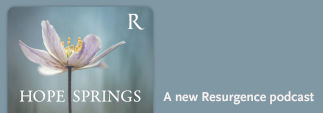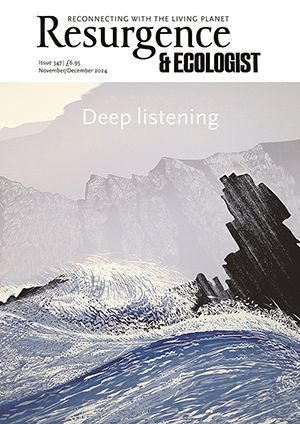I met Ruth on a Monday morning at the height of summer 2024 at one of her regular outdoor therapy areas, Bottom Moor in Derbyshire. The weather was heavy with the forecasted heat, and the far-reaching views were pure green ‘Derbyshire’. Bottom Moor is a working forestry woodland, and there was logging going on that day. This delivers different areas of vegetation: scrub and native trees as well as pine – areas of seeming devastation and island slabs of gritstone. There are wide gravelled tracks, and narrow but well used walker-made paths, so this walk is varied and suited for most abilities.
In her book Weathering, Ruth tells us about her association with rock – she is a former geologist – and how she now uses it, both physically and metaphorically, in her therapeutic work. Weathering is an act of erosion, something that is clearly visible in this physical space as the gritstone is worn away to become the sandy pathways, and in the therapeutic space something similar takes place with the ‘wearing away’ of psychological layers of defence mechanisms, traumas, restricting beliefs and behaviours, in an erosive process that allows other aspects of self to come to the surface.
As a trainee psychotherapist, I read Ruth’s new book avidly. As well as being a good insight into how very different psychotherapy can look and work beyond the classic therapy room, I found her words thought-provoking but also comforting and familiar as I was transported to landscapes and places I know well because I live in this part of the world too. The energy of the book was tangible, and I was easily able to connect beyond my eyes and ears. I also resonate deeply with Ruth’s compassion for the natural world and with her particular passion for rock.
In walking and talking with Ruth, I began to see more of how she incorporates the natural outdoor world into her therapeutic work. The well-researched wellness benefits of being in a green space are widely known, from the way it can help calm and regulate our nervous systems to the release of beneficial phytochemicals from the trees, plus, of course, the respite from human-made stimuli.
When choosing her green therapeutic space for a client, Ruth will pay close attention to how they are when outdoors, inviting them to ‘play’ with their reaction (or their non-reaction) to the landscape. How do they feel when navigating the terrain, the weather and even the wildlife? (We had a particularly good day for horseflies and very busy ants!) And Ruth also uses the landscape to help each client make sense of their own situation. In her book, she tells of a client who came to her for help with extreme overload. This client had told her she was tired of ‘living on the edge’ and Ruth says it made perfect sense to take her out to Curbar Edge, one of Derbyshire’s well-known escarpments. Here, the client was able to explore her situation, both physically and mentally.
Hidden places
As I listened to Ruth, I heard, always, compassion towards the client but also towards the land on which we live. We met on a lovely warm, dry, bright day and we talked, not just about the permanent hard landscape and the ‘here today, gone tomorrow’ trees, but also about how the seasons change the environment, and thus a person’s present state. Our discourse explored how the weather can make the paths easy or difficult. And twice we happened upon secret, special places, the kind where you want to pause for a while and take stock.
The first was a hidden copse of canopy-lifted rhododendron that Ruth calls ‘the Rhododendron Cathedral’, a place where you feel closer to ‘the Other’, a place to listen introspectively and with perhaps a playful curiosity. And the second was the remains of a building sitting in a sunken, moss-covered, stone-walled area. This place felt steeped in timelessness. Here, silence and deep listening felt called for.
These, of course, are my very personal experiences, and other people might feel differently, which is precisely what Ruth experiences with her clients, and there is beauty in that. But whatever the encounter for Ruth, the therapeutic and inner work in these environments is always about healing and self-knowledge. Using our rocky strata to reconnect someone back to themself and to the earth beneath them. Creating growth – just like when a tiny speck of grit becomes the basis for a pearl.
We noted, too, the benefit of movement. We were simply walking, with the occasional stile to negotiate. But Ruth also talked about how she would use more playful movement with willing clients and groups: movement such as dance and clambering over rocks, both of which give us access to body wisdom and body feedback, helping the embodiment of ‘know thyself’. She might introduce art making, too.
Listening then shifts from the environment and the superficial to the deeply intuitive, ‘the body knows’ kind of listening. Rekindling this kind of deep listening means that we can then move from hearing ourselves intuitively to widening out to the environment, our place in it, its value to us and our respect for it. Widening out to allow it to become part of our community, so helping us to build resilience, to be able to be ‘in’ community. Ruth uses these geologically naturally rich environments to play with these aspects, to begin to understand ourselves. What drives us? What nourishes us? How to learn to listen with our senses and bodies.
Our walk concluded with an exploration of the question, ‘As therapists working in the natural environment, do we have a responsibility to open our clients’ eyes and ears to how precious our planet is to us?’ As eco-grief and eco-anxiety become an important question of the age, how do we serve our clients and the environment? Can we honour them both, creating connection between self and the environment, both in ourselves and in our clients, rippling into creating community? Is this not the basis of great healing and growth? Questions to ponder as I reflect on Ruth’s last sentiment: life cannot be separated into parts. we are all interconnected, with each other and the earth. we would be foolhardy to forget this!








